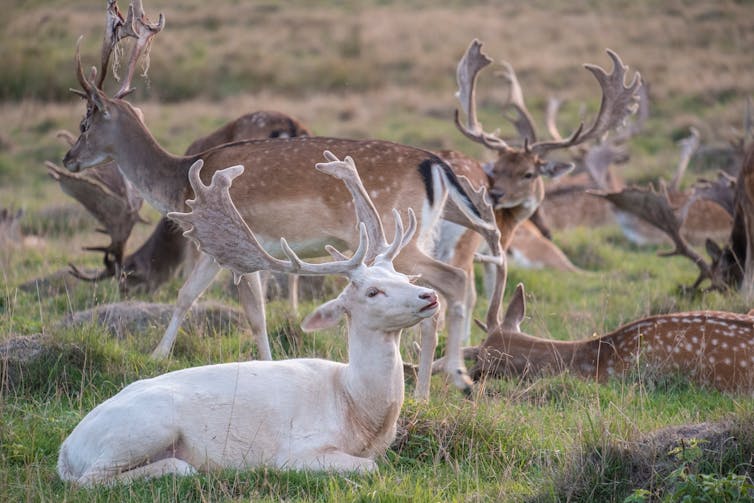why do some dogs get ‘snow nose’ in winter?
- Written by Aaron Herndon, Senior Lecturer – Small Animal Internal Medicine, The University of Queensland
This is an article from Curious Kids, a series for children of all ages. The Conversation is asking young people to send in questions they’d like an expert to answer. All questions are welcome: find out how to enter at the bottom.
My question is I am wondering why dogs get ‘snow nose’ in winter, and is it something to do with blood circulation? - Maddy, 11, Melbourne.
That is a very clever answer, Maddy! But the truth is, we don’t know why some dark brown, black or tan dogs’ noses fade during the winter months.
The dark colour in the nose (or any skin on the body) is called melanin. The more melanin you have, the darker your skin. If it happens to collect in patches, we call those freckles.
Melanin protects your skin from ultraviolet light by absorbing radiation. When you spend more time in the sun, the body makes more melanin.
 A dogs nose can turn lighter or darker depending on how much sun it gets - just like your skin might change colour after spending a day in the sun.
Shutterstock
A dogs nose can turn lighter or darker depending on how much sun it gets - just like your skin might change colour after spending a day in the sun.
Shutterstock
During winter, or if you don’t spend much time in the sun, that pigment fades.
The cells that make that melanin are called melanocytes. If your body doesn’t make melanocytes, or if those melanocytes don’t make any pigment, then you have albinism.
 Notice how this deer is white when the rest of its herd are brown. It is albino, meaning its body either doesn’t make melanocytes or its melanocytes don’t have any pigment.
Shutterstock
Notice how this deer is white when the rest of its herd are brown. It is albino, meaning its body either doesn’t make melanocytes or its melanocytes don’t have any pigment.
Shutterstock
Because these melanocytes are so involved in absorbing radiation from the sun, they are a bit prone to damage. If they get too damaged, they might become cancer.
Read more: Curious Kids: Do cats and dogs lose baby teeth like people do?
 Do you get freckles on your nose? Those are patches of melanin, the same pigment in a dog’s nose that causes it to change colour.
Shutterstock
Do you get freckles on your nose? Those are patches of melanin, the same pigment in a dog’s nose that causes it to change colour.
Shutterstock
Tumours of melanocytes are called melanoma, which is a big problem in Australia and why you must always wear a hat, sunnies and sunblock!
Dog skin is exactly the same and yours and mine. Hair colour and skin colour is the result of how much melanin is in the hair or skin. Most all the different colour variations you see are really just a result of how much melanin is in the skin and hair.
In some dogs (particularly breeds like the husky and some retrievers) their noses will lose some pigment in the winter. Occasionally this is permanent, but usually it fades in winter and gets darker in summer.
It is the melanin coming and going, just like a tan.
We know that’s not the whole story, because it’s not the entire nose that loses pigment, it’s down the middle and along the top. But it’s the best idea we have!
Maybe it also has to do with temperature, and that will be influenced on blood flow, just like you suggested! Your answer might be “right on the nose” after all.
Read more: Curious Kids: Why don’t cats wear shoes?
Hello, curious kids! Have you got a question you’d like an expert to answer? Ask an adult to send your question to us. You can:
* Email your question to curiouskids@theconversation.edu.au * Tell us on Twitter by tagging @ConversationEDU with the hashtag #curiouskids, or * Tell us on Facebook
 CC BY-ND
Please tell us your name, age and which city you live in. You can send an audio recording of your question too, if you want. Send as many questions as you like! We won’t be able to answer every question but we will do our best.
CC BY-ND
Please tell us your name, age and which city you live in. You can send an audio recording of your question too, if you want. Send as many questions as you like! We won’t be able to answer every question but we will do our best.
Authors: Aaron Herndon, Senior Lecturer – Small Animal Internal Medicine, The University of Queensland
Read more http://theconversation.com/curious-kids-why-do-some-dogs-get-snow-nose-in-winter-104131



